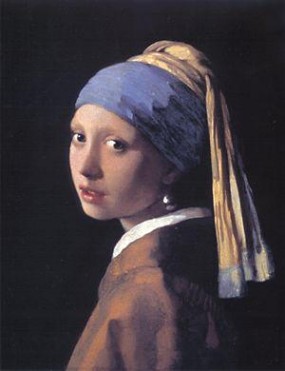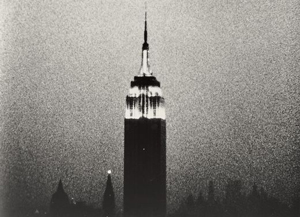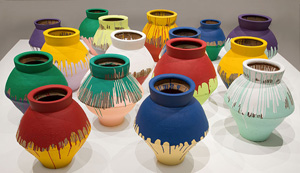Take Your Time
John Haberin New York City
Slow Art, Warholism, and Oscar Murillo
Take your time. Art rewards it. Truly looking at art demands it.
Art has always asked to take your time. How can you possibly connect with other cultures and beliefs, distant in space and time, without it? How can you respect art made for churches, monuments, and rituals without at least some degree of reverence—and without the time it takes get past the reverence and the selfies to see what lies right before your eyes? Modernism made the demand still more pressing, by raising a tough question: why is that art? In all these ways, art tempts you to walk away quickly and indignantly, but at your loss. 
Some of us, of course, take pride in knowing how to look, whether we deserve it or not. And some are now making the demand of the artist: it is up to the work to take your time, and, they say, too much art hardly even tries. A CUNY professor, Jennifer Samet, calls for "slow art," and the term has gone viral. The demand sounds reasonable, but it grows more superficial the longer one looks. So, too, do attempts repeated by Jed Perl to pin the death of slow art on Andy Warhol, while Oscar Murillo shows how even a sad spectacle can come with serious intentions.
Slow food for thought
The demand for slow art sounds reasonable enough—or even essential. You surely expect it: art should stop you in your tracks and hold you. People wait in unbearable weather to see a room of lights and mirrors by Yayoi Kusama, and guards may need to prompt them to leave. The Frick gave Girl with a Pearl Earring its own room, among loans from the Mauritshuis, on the expectation that people could hardly tear themselves away. I have never seen much of the Uffizi in Florence to this day because an Adoration of the Shepherds by Hugo van der Goes would not let me go.
So what if the demand often falls on the viewer? This site is dedicated to giving you the tools you need, because art insists on it. Why in the world would one spend minutes transfixed by paint drips or colored rectangles, and why do order and emotion slowly emerge after all? A critic can help, although you may still wish to move on. Still, that says little more than that Jackson Pollock and Mark Rothko are pretty good artists. What can talk of slow art add?
The term takes off from slow food, which already should have one wondering. How can a trendy label for celebrity chefs and hipsters, already twenty-five years old, supply a model for rejecting trends, celebrities, and hipsters in art? Samet's own downtown gallery, worthy as it may be, does not stand out from its neighbors in mission or results, and she has delivered a talk at a Chelsea gallery that is worse. As I write, candidates for the worst art galleries in Brooklyn have joined with others outside the city in a "slow-art day," without a trace of doubt that it would benefit them. Besides, good art criticism should care more about understanding than rating. How can supposed defenders of art put such faith in judging?
Then, too, some art takes very little time, until later. Marcel Duchamp took no time at all to send art reeling. Complain all one likes about art as one-liners, but real one-liners work by moving fast and sticking in memory, to the point that one cannot get them out of one's head. An Untitled Film Still by Cindy Sherman or a headline from Barbara Kruger works the same way. Other art depends on its very transience, like Robert Smithson's Spiral Jetty, with its habit of vanishing beneath the surface of the Great Salk Lake. In political art, a reminder of transience can bring home the cost of a human life.
Conversely, conceptual art can take a great deal of time, at least for the artist. Performance artists like Chris Burden and Marina Abramovic have endured suffering and scrutiny in which a moment seems to last forever. Trashy installations may crowd out painters and sculptors, but who knows how long it took for Tara Donovan to collect all those plastic cups—and to transform them into a visionary landscape? Slickness has a long history anyway. Antonio Canova, as with Canova's Washington in the early 1800s, revered the past enough to call his sculpture Neoclassicism, but he left much of it to assistants. Damien Hirst would be jealous.
To complicate things further, a tribute at MoMA to a great dealer in a slower time, Ileana Sonnabend, included Warhol and perhaps the seeds of celebrity art today. Sure, something has changed. Where once museums could provide a respite from the larger world, now blockbusters move the troops. Crowds rush from opening to opening, leaving little more than a warm buzz. High-end dealers deserve every bit of their reputation for commercializing art, in that "battle for Babylon," and commercial pressures alter what artists can hope to achieve. But then why treat "slow art" as a matter of will?
Keeping time
Slow time is in the eye of the beholder. When Minimalism entered the scene, critics felt the loss of "absorption" in painting and sculpture. If anything had become simplistic or impersonal, others replied, it was dull retreads of expressionism and abstraction. They celebrated instead a viewer's active engagement in the art object and the space around it. Now, this example hardly rules out slow art, since both sides claimed it as their own. It does, however, show that ideal as no more than the everyday judgment of a work of art.
It also shows how that ideal can get caught up in nostalgia for the good old days in today's "atemporal world," very much like right-wing cries for "family values." No wonder Jed Perl and Hilton Kramer, who see declining standards in art, have made their case in neoconservative journals. They and Robert Hughes also have a way assigning blame to what Perl calls "the curse of Warholism." They blatantly set aside that Andy Warhol was an artist, not an ism, at least at first. Out goes the Andy Warhol who confronted a culture's obsession with death and celebrity, and in comes the gnomic art star. And out goes slow art.
 Few artists deserve to be judged for their private parties or public statements, no more than one should judge Ad Reinhardt solely for his cartoons. And Warhol's influence did extend widely—but not to a loss of belief in art. It led a philosopher, Arthur C. Danto, to recover art as a meditation on its very existence. It led the "Pictures generation" to question how images proliferate, and (on a lesser note) it led American culture to an image of Barak Obama as populist hero. It also led to new avenues for performance, collaboration, and video. It is hard to see Douglas Gordon, Christian Marclay, T. J. Wilcox, and their video explorations of real time apart from Warhol's Empire.
Few artists deserve to be judged for their private parties or public statements, no more than one should judge Ad Reinhardt solely for his cartoons. And Warhol's influence did extend widely—but not to a loss of belief in art. It led a philosopher, Arthur C. Danto, to recover art as a meditation on its very existence. It led the "Pictures generation" to question how images proliferate, and (on a lesser note) it led American culture to an image of Barak Obama as populist hero. It also led to new avenues for performance, collaboration, and video. It is hard to see Douglas Gordon, Christian Marclay, T. J. Wilcox, and their video explorations of real time apart from Warhol's Empire.
Yet the criticism also overstates his influence, in order to paint artists after him as villains. Warhol did not invent Pop Art, coming as he did after Jasper Johns and Robert Rauschenberg, and it took its own course, with Roy Lichtenstein and others. Slow-time video and film got along quite well apart from him, thanks to Nam June Paik and Michael Snow. Warhol's influence even declined as Frank Stella came to stand for the triumph of American painting. And now painting is back, big time. Do not blame Warhol if it does not look quite like what you expect.
As 2014 began, a small gallery was running Empire continuously, on loan from MoMA. One could experience it as one never could in a museum, in a dark room on the Lower East Side. It looked grainier than one could possibly remember—and closer to the pulse of the city. A slight speed-up compressed the shot of the Empire State Building to under eight hours, but it still took its time and yours. The building looked once again like a monument illuminated at night, rather than a billboard for a colored light show. New York itself became slow art.
Artists still have to make art worth knowing, because otherwise one will move on, quickly. They feel that need every day. Fast or slow, they feel it as both a duty and a thrill. So should one abandon the idea of slow art or claim it as one's own? It hardly matters, so long as one does not use it as cure-all—or for resentment at the success of others. The burden of knowing is still on you.
Candyland
Oscar Murillo wants you to take a candy, but think carefully before eating. And he means it, seriously, but is it Candyland all the same? He has converted a garage-like space in Chelsea into a Third World candy factory, with its output free for the taking. You can take as many as you like, individually on racks or already foil wrapped, with a bright yellow smiley that leaves no doubt that you have seen the cheery face of global capitalism. Just be aware of the reality around you, including photographs of workers in Murillo's native Colombia and the computer graphic of an assembly line in unending action. And then, he adds, consider distributing them throughout the city, where they might actually do some good.
Popular artists these days want ever so much to be taken seriously, almost as much as girls just want to have fun. For Ai Weiwei even before his ambitious fences around New York landmarks, a memorial to victims of the 2008 Sichuan earthquake gains in weight by a matter of tons with each stop of his retrospective. For James Franco, a turn to art alone asserts serious intent, in his dreadful restaging of Cindy Sherman with himself film star as the lead. Hirst led the way, with a dead shark, a shallow tank, and a shallower title. Not that everyone is buying, though, not with what can seem a downright cynical plea for attention. Free candy, anyone? 
Struggling artists can be among the first to pounce, but could they be seriously wrong? Anyone who wants original work to be judged on its own terms, apart from conformity to the market, owes it to others to take their ideas seriously as well. Murillo critiques a well-meaning spectacle, by repeating the offer of candy from Félix González-Torres or of food from Rirkrit Tiravanija—but with a reminder of consumerism and globalization rather than a promise of participation and community. As for Franco, surely he has better ways to gain attention than making art, like, say, going out for a date. Tellingly, no one calls his turn to the stage in Of Mice and Men anything less than sincere. Critics just call it leaden and lame.
Artists can easily resent a show as attention getting, because they can easily overstate the public appeal of art. After all, art means a great deal to them, so surely it must mean a lot to others as well. One has, though, to look past the niche appeal of big installations and big-ticket sales to the genuine plight of artists and dealers everywhere, most especially but not exclusively midlevel artists and dealers. The same resentment runs through pleas for "slow art." The pleas sound reasonable enough, but then one might have to take Murillo slowly as well. One is not giving him a free pass by doing so either, but rather newly able to criticize his motives and his work.
Without that, in fact, one is left with little more than name calling, like a wingnut responding to Obamacare with cries of socialism. At that point, face it, the debate is already over. And yet market pressures do matter in art, and celebrity artists need to be seen in their light as well. Murillo, Ai, and Franco combine serious intentions with a comic eagerness to please, and the tangle can be as fatal as for Tiravanija's "relational esthetics" before them. Murillo's factory, A Mercantile Novel, looks more like a warehouse—and an airy, clean, and welcoming one at that (although it reverted to the labor of packaging, off-limits, after the opening). Computer graphics only add to the spectacle, and goodness knows what it all has to do with video of an upscale corner in Tribeca.
At the opening, a woman next to me was counting how many foil packages she could grab, and she hardly cared that they were the Colombina corporation's signature formula of marshmallow and cocoa. (I, for that matter, was scarfing down a beer.) Before the opening, too, the press was ringing in the event with such headlines as "Oscar Murillo Is the Art World's Next Big Star." Murillo made his mark with big canvases mixing gesture and text, often compared to Jean-Michel Basquiat and Julian Schnabel. Schnabel's work from 1979 and 1980 may once have seemed the ultimate in empty spectacle, in its mix of Neo-Expressionism and irony, but it looks more prescient in the explosion of painting today. And Murillo's art, too, is serious, and one should take it seriously—while bearing in mind that good intentions may just not be enough.

Warhol's "Empire" ran at James Fuentes through January 26, 2014, Oscar Murillo at David Zwirner through June 14, and Julian Schnabel at Gagosian through May 31. Jed Perl's review of "Regarding Warhol" and Warhol's influence appeared in The New Republic of November 15, 2012. The international "slow art day" took place April 12, 2014.




